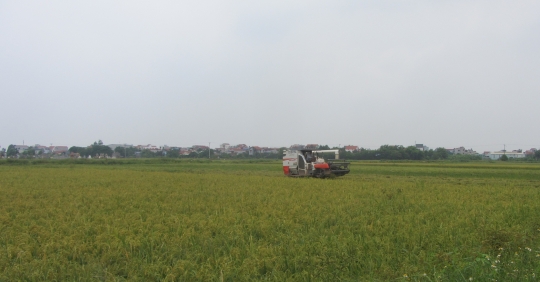Mr. Luong Dinh Trong in Tan Viet Township, Yen My (Hung Yen) and 4 other households planted more than 63 ha of all kinds of rice. Although the weather did not favor the rice in this year’s spring-summer harvest, Trong’s group still achieved an average yield of 2 quintals/sao (360 m² stick, equivalent to 55.4 quintals/ha). According to the price at the time, Mr. Trong and the group’s households made a profit of 500,000 VND/Sao.

The combine harvester harvests rice in Mr. Trong’s model. Picture: HaiTien.
To support production, Mr. Trong mobilized group members to contribute capital to purchase various machines and mechanize heavy production steps such as tillage, transplanting, harvesting, watering and pesticide spraying. At the same time, Mr. Trong also connected large rice fields to rice processing plants for export in Yen My City. Accordingly, Mr. Trong’s group has been exclusively growing glutinous rice of all kinds (Nep 415, Glutinous incense, Glutinous 97) to supply these farms for many years.
However, Mr. Trong still said that this year’s rice production suffered a double loss, especially compared to last year, the rice yield fell by 10-20%, and the selling price of rice also fell by 10-12% (depending on the variety ). ). .
Mr. Trong reiterated, “Thanks to the purchase of many kinds of agricultural machinery, without renting and borrowing, the labor force is profitable. When the production is small, we have to hire all the labor of plowing, planting and harvesting, which has a negative impact on capital.” . is the safe bet”.
Ms. Dang Thi Nhung transplanted nearly 2 hectares of Bac Thom 7 and Nep 87 rice because she needed to rent a machine to till the land, sowing, harvesting and spraying pesticides, so that in the rice harvest last spring about 5 million Dong were lost.

Rice from the paddy field is poured directly into the automobile and transported to the house. Picture: HaiTien.
Ms. Nhung analyzed that the loss of capital was still a godsend as she had to stop all the hard work and hire out. In addition, the weather is very harsh, there is little rain, which causes the rice plants to grow slowly, grow poorly, have few flowers and have short stems; At the beginning of the flowering period, it rained continuously for many days, accompanied by late cold. The cold lasted until late April and early May, adversely affecting the flowering and drying of rice plants, resulting in low yields. The emerging paddy fields are exposed to the cold and have white heads or no seeds.
In addition, since Ms. Hoa has planted a large area with the Bac Thom 7 rice variety, which is of high quality but less cold-resistant and less tolerant of intensive farming, its tolerance is also lower than that of the glutinous rice varieties.
Meanwhile, the rice production linkage model of Mr. Luong Van Tranh and Mr. Luong Dinh Tam (Tan Viet Township) achieved better income. Covering an area of 20 ha of accumulated fields, Mr. Tranh and Mr. Tam planted 100% of the Nep 415 variety and invested in many means to mechanize rice production, so that they still make a profit of 600,000 VND/sao (nearly 17,000 VND/sao) achieved million VND/ha).

Large fields associated with sticky rice production. Picture: HaiTien.
Mr. Tranh also said that compared to last year’s spring rice harvest, he lost about 400,000 VND/Sao due to the influence of the weather and low rice prices. Sticky rice variety 415 (popularly called sticky rice because the rice seeds are larger than normal) has a fairly long growing season (145-150 days), but is cold-tolerant, intensive cultivation and high yield (70-75 tons/ha). clear rice, delicious fragrant rice, always sold at a high price.
Through years of practice of producing large rice fields, Mr. Tranh pointed out: Using drones to spray pesticides for rice is not as effective as improving spray nozzles for cars and motorcycles, which are then attached to the head of a plow, water pump, etc Turn on the generator and then pull out the hose to spray across the field.
“High-speed drone spraying, solid phase spraying capacity, high scattering of the drug, difficult contact of the drug to places with heavy pest and disease load, especially in the stalk, on rice roots, etc. This is also the common comment from farmers, the big Produce quantities.” Rice fields in Hung Yen and Hai Duong,” commented Mr. Tranh.

Ms. Nhung took advantage of the sunny weather to dry the rice. Picture: HaiTien.
For intensive cultivation of glutinous rice 415, it is necessary to carefully and finely plow the soil and timely prevent pests and diseases such as rice blast, powdery mildew, physiological yellowing, leaf roll, stem borer, etc. The average yield of 415 glutinous rice reaches 2.4-2.5 quintals/Sao, good intensive farming and favorable weather, the yield can reach 2.6-2.8 quintals/Sao.
The city of Yen My is an important rice processing center in the north. The glutinous rice processed here is mainly exported to China. In addition, it is also supplied for consumption in the northwestern highlands. Currently, ethnic minorities in the Northwest are actively converting the precarious rice-growing area to planting vegetables and fruit trees in order to increase agricultural efficiency. Accordingly, the Northwest is a big market for rice consumption, including all kinds of glutinous rice,” said Mr. Luong Dinh Tranh.

